

About
For Teachers
- inelastic collision same mass.mp4
Credits
Author: Leong Tze Kwang, Lim Beng Choo
Document Brief: Title: "Tracker 3/5 Perfectly Inelastic Collision with Same Masses by Leongster"
This document examines a 3/5 perfectly inelastic collision scenario where two objects of identical masses collide and stick together post-collision. The focus is on momentum conservation, energy dissipation, and the behavior of perfectly inelastic collisions with a significant energy loss.
Study Guide:
Objective: Analyze the dynamics of a 3/5 perfectly inelastic collision involving two objects of equal masses, emphasizing momentum conservation and energy transformation.
Key Concepts:
-
Perfectly Inelastic Collisions:
-
Collisions where the colliding objects stick together after impact, resulting in maximum energy loss while conserving momentum.
-
-
Conservation of Momentum:
-
The total momentum before and after the collision remains constant: , where is the mass of each object.
-
-
Energy Dissipation:
-
A large portion of the system's kinetic energy is transformed into other forms, such as heat, sound, and deformation.
-
-
Final Velocity Calculation:
-
The shared velocity post-collision is , assuming equal masses and perfect inelasticity.
-
Experiment Overview:
-
Setup: Two objects of equal mass collide on a frictionless surface and stick together after the collision. Motion is tracked using software like Tracker.
-
Procedure:
-
Measure initial velocities of both objects and the final shared velocity post-collision.
-
Validate momentum conservation.
-
Calculate the percentage of kinetic energy lost during the collision.
-
-
Observation Points:
-
Shared velocity of the combined mass after impact.
-
Energy lost as a fraction of the initial kinetic energy.
-
Questions to Consider:
-
What happens to the kinetic energy in a perfectly inelastic collision?
-
Answer: A significant portion is dissipated as heat, sound, or deformation, with only a fraction retained as kinetic energy.
-
-
How does the mass symmetry affect the final velocity?
-
Answer: Since the masses are equal, the final velocity is the average of the initial velocities.
-
-
Why is momentum conserved but not kinetic energy?
-
Answer: Momentum is a vector quantity conserved in all collisions, whereas kinetic energy can transform into non-kinetic forms in inelastic collisions.
-
Applications:
-
Understanding energy loss in material testing and collision safety.
-
Designing systems where energy dissipation is crucial, such as protective barriers.
-
Teaching principles of momentum and energy in physics education.
FAQ:
-
What defines a perfectly inelastic collision? It’s a collision where objects stick together post-impact, resulting in maximum kinetic energy loss while conserving momentum.
-
What does 3/5 signify in this context? It indicates that 60% of the initial kinetic energy is lost, leaving only 40% in the system's final kinetic energy.
-
How is the final velocity calculated? By using the conservation of momentum: .
-
Is momentum always conserved in such collisions? Yes, momentum conservation is a fundamental principle that applies regardless of energy loss.
-
What insights can this study provide? It offers practical understanding of collision dynamics relevant to engineering, vehicle crash analysis, and material deformation studies.
- Details
- Written by leongster
- Parent Category: 03 Motion & Forces
- Category: 02 Dynamics
- Hits: 5438
